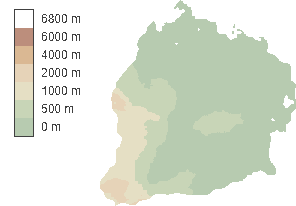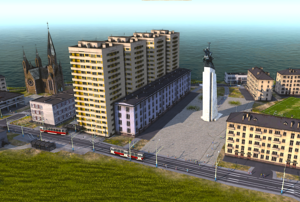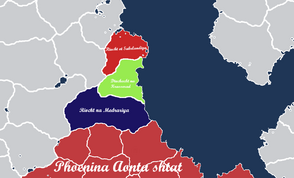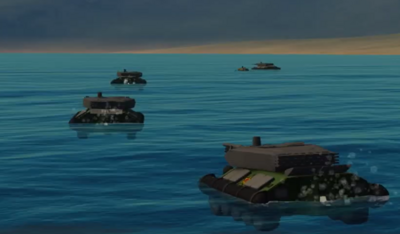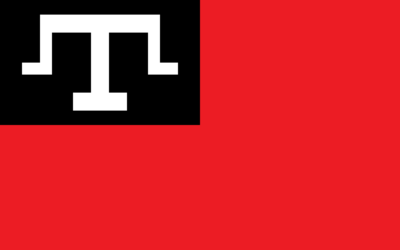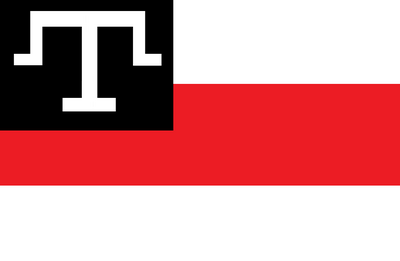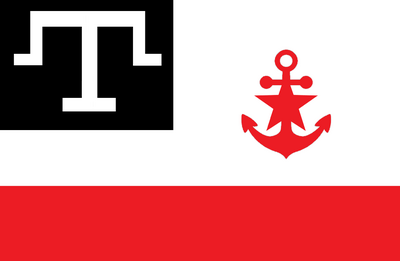Sahr
|
Kingdom of Sahrland
Sahrlandiya
|
|||||
|---|---|---|---|---|---|
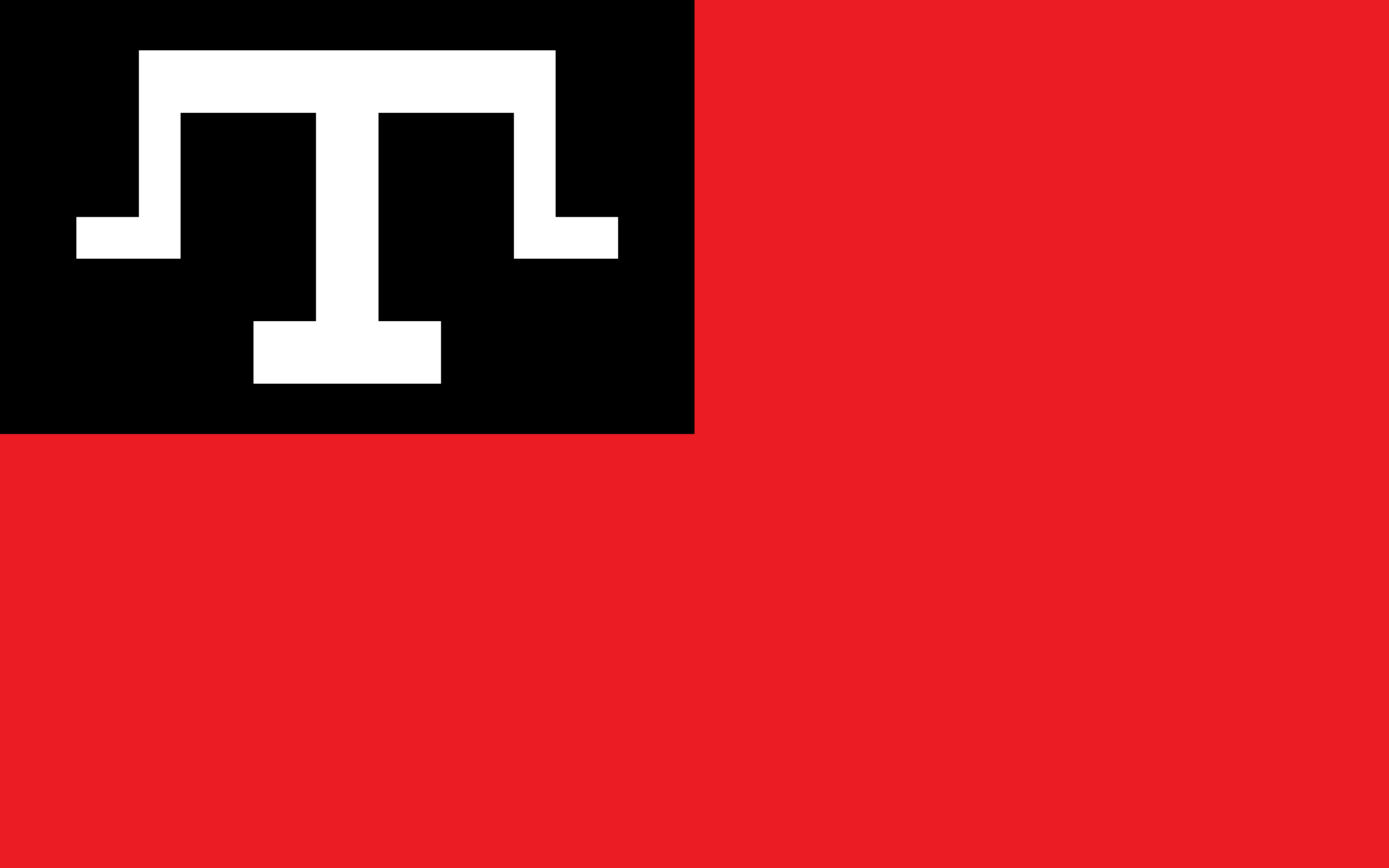 |
|||||
| Motto | "Slavsya, Sahr!" (Be famed, Sahr!) | ||||
| Common Name | Sahrland | ||||
| Anthem | "Hymn of the Sahrlands" | ||||
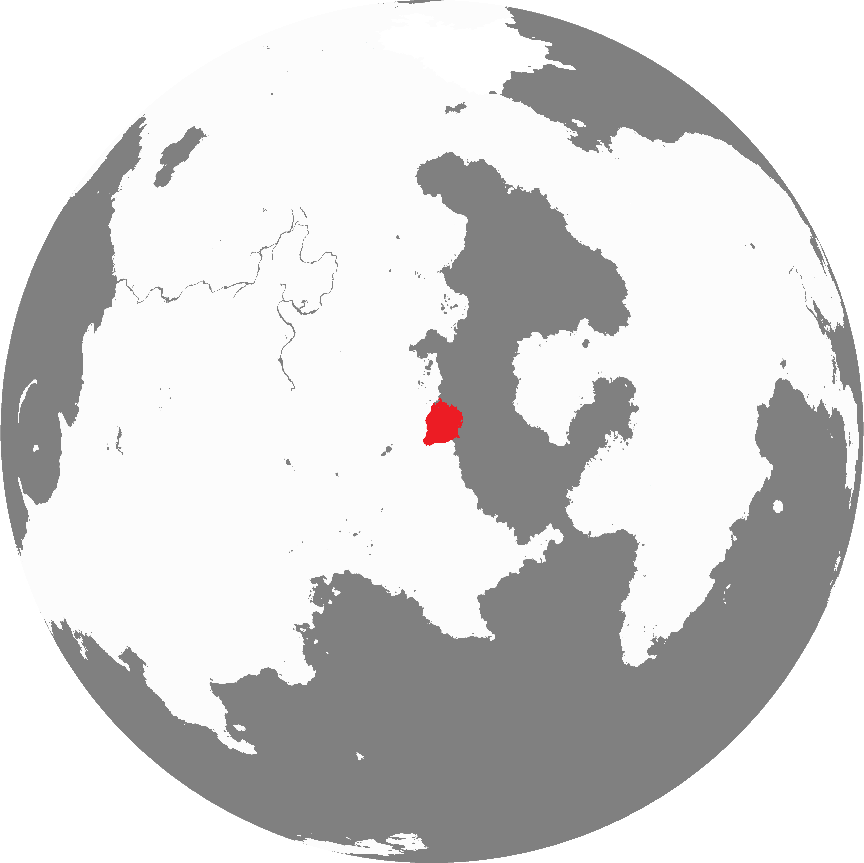 |
|||||
| Demonym | Sahren | ||||
| Official languages | Egercian, Tekkian | ||||
| Currency | Rút | ||||
| Politics | |||||
| Capital | Khosa Dugthail |
||||
| Government | Semi-Constitutional monarchy | ||||
| Foundation | 2106 | ||||
| Preceded by | Chevspendi | ||||
| Followed by | n/a | ||||
| Demography | |||||
| Ethnicities | Egercian, Chevspendic, Vagani, Chosain | ||||
| Population | 6'893'620 | ||||
| Area | 14'633 km² km² | ||||
Sahrland, otherwise known as the Kingdom of Sahrland (Egercian: Riocht na Sahrlandiya), is a hilly state north of Tekkia. Sahrland has an extensive coastline connecting to the Sea of Kolus. To the south lies Phoenia, and the Western Norian Steppe leads to Sceania. It's two capitols are Khosa and Dugthail.
| “ | Sahrland is a riddle wrapped in a mystery wrapped in an enigma. | ” |
| —John Kallan Kurrman | ||
Etymology
The name sahrland comes from the Burric Chevspendi people which called this land "Sahrlandiya" literally translating as "Sweet Lands" in reference to the fertile soil. When they settled into this region Grand Cynaz Miden 1st adopted the title of Grand Prince of Sahr, formalising the nation. A careful programme of linguistic reform and interracial marriages was undertaken to integrate the native Egercians and the Chevspendics into one culture. This results in "Sahrland" representing the state and "Egercia" representing the people and the land. In modern times the two terms have come to be almost interchangeable.
Another theory states the name is possibly derived from the proto-Burric word şahar, meaning town or settlement, as the Chevspendi were a nomadic people before they settled the area.
Geography
Sahrland's geography is dominated the two major rivers , and the Balaoigir mountains which divide the nation in half.
Khelym and Srudeighe
Aontan colonists settled Egercia in ancient times, naming the southern egercian river "Srudeighe" meaning "ice flow" because it is primarily fed by glacial runoff.
Avienne nomadic nations and city states were the first to name the northern egercian river, calling it "Heluum" meaning "flow" referring to it as an artery of Kerbin's energy. The name drifted to Khelym after the Chevspendics migrated there.
Balaoigir mountains
Kyzets ridge
Chevspendic tribes named this ridge "Kuzets" meaning "Hidden" because the terrain was dangerous due to the ease of getting lost. It is directly between the northern part of the Balaoigir mountain range and the northern coast, with foothills between both. The ridge is dominated by the Kyzets mountain which is now considered a sacred site.
Climate
Sahrland is primarily made of steppe and savannas, and recieves significantly more rainfall than the deserts to the south. The southern regions of Sabri-Ria are colder than the rest of the nation due to relative elevation.
| Region | Temperature (noon, celcius) |
|---|---|
| Klensagrad | 25 |
| Khosa | 24 |
| Slovale | 24 |
| Dugthail | 21 |
| Sys | 24 |
| Hedaile | 24 |
| Rokfor | 11 |
| Ria | 19 |
| Mt Kol summit | -24 |
| Mt Kyzets summit | 0 |
| lake khogildir | 28 |
| Ken-Arai | 24 |
Biodiversity
Sahrland is home to the most Capal breeds, at around 193. This number contrasts popular belief that it contains 211, which comes from an incorrect Karlo Frakchiya quote.
| “ | Who can govern a country with two hundred and eleven kinds of capal?!?. | ” |
| —Karlo Frakchiya | ||
Urban Areas
Khosa was historically the capital of the country since it's creation in spite that Dugthail was often larger or equal in size. The city remained the location of the Parliamant and became the location of the Presidency while the location of the monarchy has remained in Dugthail since the 2139 coup. Other noteworthy areas are Klensagrad, named after the peninsula it inhabits, and Slovale, which is also coastal despite being significantly farther north. Sys is the farthest from the coast and the smallest, and is also the farthest south of all the cities in Sahrland proper. Within the two recently gained provinces of Baile and Kravsmad, there are 3 more significant cities, named Baile, Heidli and Rokfor respectively. Urban areas in the northern region are less populated and prosperous than the southern regions as the south has been untouched from the civil war and internal population migrations caused by the hysteria of 2160.
Politics
Government
Sahrland has two leaders, the king which is a hereditary title and the president which is an elected title. The parliament serves to ratify new laws. Both the president and king have executive power, making Sahrland an absolute monarchy which is also constitutional and a democratic republic. The presidential and parliamentary branches are set in Khosa, while the monarchy resides in Dugthail. </gallery>
| President | Party | King | Term | |
|---|---|---|---|---|
| 1st | Nedfry Svoboda | Republican coalition | Kirbo Lavro | 2144 - 2150 |
| 2nd | Karlo Frakchiya | Worker's party/United Aontas front | Kirbo Lavro | 2150 - 2157 |
| 3rd | Daria Adaman | Koknar's party/Nælfonds/New Strecha Movement | Kirbo Lavro | 2157 - 2165 |
| 4th | Kelbert-dua Tengin | Worker's party/Strecha Movement/Second Labour party | Kirbo Lavro | 2165 - 2185 |
| 5th | Malkhaz Adaman | Koknar's party/Nælfonds/Worker's Party | Kirbo Lavro | 2185 - 2190 |
| 6th | Danak Kyrt | Worker's party/Nælfonds | Kirbo Lavro | 2190 - 2199 |
| 7th | Danak Kyrt | Worker's party/Nælfonds | Reydi-kæ Lavro | 2199 - now |
Subdivisions
There are three regions in Sahrland, five provinces, nine counties, and ten municiple governments.
Foreign Relations
The concept of Nemqurpolitik comes from the Chevspendic language meaning "Indifferent politics". The strategy has guided the Sahren nation since it's inception regardless of administration. Tekkian interests in Sahrland allowed the ideology to flourish as the nation was free to be aggressive against others as any retribution would invoke Phoenian intervention. From 2160 to 2200 Nemqurpolitik saw it's only decline as pan-Aontism spread.
Demographics
Language
The official and most commonly spoken language of Sahrland is Tekkian, specifically the Egercian dialect. Chevspendic is rarely used in day to day life because Egercian was used a way to unify the country linguistically, instead Chevspendic is primarily used for sacred ceremonies or complex literature. The Sahren Chadastok area is an exception, with a multilingual culture unique to that region.
Education
In the Sahren constitution citizens are garunteed access to free general education, which consists of an eleven year "Public education" (Oideachas poibli) The estimated literacy rate is 98.9%. Students in the 11th grade take Government exams, which are also referred to as school-leaving exams. These tests are later used for university admissions.
One of the oldest and most prestigious is Goeth-an-Tuascirt university in Klensagrad, founded in 2047 and named after a Chevspendic warlord who according to legend drove out a rival nomadic tribe which conducted slave raids in the Egercia region. Other prestigious universities of note are the University of Dugthail, Slovale technical university, and Ria's Gymnasium of Higher Sciences.
By the end of the second five year plan 21 institutions of higher education had been established.
Religion
Sahrland has a majority Eubud population. The 2190 demographics survey revealed 87.5% of the country follows Eubudism. The religion was introduced by the Chevspendic invasion of the early 2100s. As the Egercian culture and Chevspendic cultures assimilated into eachother, Eubud saw a period of growth. The House of Lavro has been made up of Eubudists since the state's creation.
Culture
During the first half of the 22nd century Sahren identity was heavily debated within the state. In the background of every daily happening was a conflict between Chevspendic traditionalism, Pan-Egercianism, Pan-Aontism, Chevspendic nationalism, Urban, Rural, and Communal. Under the demands of Grand Prince Miden 1st the Chevspendic invaders adopted the same language as the Egercians whose land they conquered, which set the foundations for the culture of modern day Sahrland. After the Sahren Civil War ended in Republican victory, the new government emphasized the development of Sahren culture in new directions.
The Capal holds a significant stranglehold over Sahren culture, in this manner only Sarconian culture can be compared to. Sahrland's late founding as a nation, slow industrialisation, and relative geopolitical isolation for most of the early history meant infrastructure developed around existing methods which were used due to a lack of infrastructure (a phenomenon often called Harbourization). As a result Sahrland possesses some of the most efficient Capal based transport and industries. It has been estimated 60% of citizens own one or more Capal. How one treats a capal is considered telling of one's moral character, as such cruelty of Capals is heavily stigmatised and consumption is highly illegal.
Holidays
Notable holidays are New year's day, Day of victory (referring to the Sahren Civil War), and Svoboda's day.
Art and Architecture
The Chevspendic people possessed only nomadic architecture, so Sahrens derive their current Architectural style from Tekkia and paneled structures commonly seen in planned economies across the country.
During the Frakchiya administration a style of mass produced paneled structures was introduced as a way to rebuild residential areas post civil war. Colloquially these are called things like Frakchinas (Frakchiyanians), Coiri (Boilers), Stihlibloic (Stilovist-Blocks) or more derogatively, Broga-boskai (Shoeboxes). Many express criticism at the poor aesthetic variety of Sahren paneled housing, resulting in many of them being renovated or decorated in the decades following their construction.
Cuisine
Sahren cuisine reflects burric practices mixed within the traditions of the lands the Chevspendi inhabited. Well known Sahren foods are kebabs, mezes, and various dough and dairy based desserts. Olive oil is also considered a key component of the Sahren culinary tradition.
Alcohol is consumed often in Sahrland, contributing to a variety of health and cultural issues. According to a 2198 report, 36% of Dugthailites were hazardous drinkers. It is estimated the second leading cause of death is from alcohol related complications. A notable example is the first president Nedfry Svoboda, whose condition of cirrhosis was likely caused and exacerbated by alcoholism.
Literature
Sahren literature goes back hundreds of years in varying forms. Pre-Chevspendic invasion Egercian literature is largely derived from Tekkian literature fused with the raiding-wrought environment of Egercia. These are charactarised by themes of courage, strength, resiliance, and a constant struggle for survival. Chevspendic oral tradition followed similar themes, but also took influence from Eubudic and Surnish literature. After the mass adoption of the Egercian language the two styles merged, preserving many Chevspendic oral stories in writing that otherwise may have been lost.
Kumarliq era
After the Chevspendic invasion began a period known as Kumarliq initially characterised mostly by themes of religious piety and mercy, but then developed more Romantic styles as a form of anti-war rebellion against the War of the Egercias. In this sense the Kumarliq era was defined as both Mysticism, Enlightenment, and Romanticism all at once. Philosophy of this time has ties to Eubudic Anarchism which would have significant effects in politics in the years following.
Miden 1st also continued to cultivate an Egercian speaking intellectual class which effectively brought the participation of culture to all classes.
Republicanist Art
Post Sahren Civil War almost every institution and behaviour was dismantled and replaced with a counterpart inspired by Svobodism, including art and literature. This period is known as Sahren Republicanism, and is charactarised by the ending of eras, Collectivism, Experimentation, Science, and Reason. Media repression laws also led to the Svobodist Realism which intended to show life improving under the Republican system.
The gap era
After the 2160s and the associated spontaneous economic hardships and reorganizations, Sahren literary works declined in number drastically and the printing industry completely fell through. It took until the 2180s for recovery as new artists filled in older ones.
| “ | The Chevspendic and Egercian peoples have lost their love for culture in the face of adversity. | ” |
| —Verdade article from Gardo 2164, author unknown. | ||
Ascensionism in Practice
Movements like Ascensionism have a long history throughout time, but became primarily prevelant in Sahrland from the 2180s onward. This period is charactarised by a return to certain Kumarliq elements in it's adoption of Mysticism and Anti-war rhetoric, along with Futurism and Nemqurpolitik. The name used to describe this era is derived from the Ascensionist political movement spearheaded by the author and activist Frei-ako Tengin.
| “ | Verily I say and have proven with my own life, "time" also a nonsense concept. Fabricate thy goals thyself, and thou shalt already liveth where it hath happened. | ” |
| —Frei-ako Tengin, The Ascensionist Edict. | ||
Theatre and film
Sahrland possesses a thriving theatrical tradition which is derived from Chevspendic storytelling and the nonexistant domestic film industry in pre-invasion Egercia. This has had a profound effect on the history of theatre, producing some of the most renowned actors, playwrights, and works of it's time.
Some of the major theatres include An tóirse, The Ria playhouse, Bancwich forest hall, Slovale theatre, and Yuariblaath theatre.
The Sahren film industry developed largely in the 2150s to produce patriotic films for the Republicanism movement and the five year plans. Numerous indigenous films have been produced since the Egercian film board was founded, such as the film adaptations of Rory-kæ Abzalev's Klara Fayle and The Last Summer.
Military
Sahren Republican Guard Air-corp
- Main Article: Sahren Republican Guard Air-corp
Sahren air doctrine revolves entirely around battlefield support and disruption of enemy air support. The airforce is integrated fully into the army as the Sahren Republican Air-corp.
Sahren Republican Guard
- Main Article: Sahren Republican Guard
The Sahren republican guard was created as the most well equipped and trained divisions of the Republicans during the Sahren civil war. It is stressed that the SRG is to be put under control over the state and de-politicized. It has since has become a very small professional force intent only on policing the borders of Sahrland. Since it's founding, the SRG has only fought in border conflicts with various groups like the South Sahrland Revolutionaries and Free Army of Hartfordia. Many have come to question the gutted force's effectiveness in a conventional war.
- Main Article: Sahren Navy
The Sahren Navy was created as soon as the country was founded but had no capital ships until 2133. By the start of the civil war Phoenian and Zokesian naval power projection prevented any mutiny, causing the Navy to be neutral apart from the SN Khosa and SN Blokha defecting to Phoenia. Due to this defetion the Sahren Navy was absorbed into the Republican alliance rather than foundeding a new one. Post war the Sahren Republican Navy purchased two destroyers from phoenia, and continued developing the Slovale and Blokha class, which were once more cancelled in the hysteria of 2160. The Sahren Navy has seen no combat since it's founding and has little in the name of naval theory or experience.
Korych
- Main Article: Korych
Founded in 2182, the Korych are an organization that make up of the most trained and equipped Sahren paratroopers. Their separation from the Sahren Republican Guard allows for operational flexibility the SRG lacks.
Economy
Agriculture historically has been and is currently the largest sector of the Sahren economy. Of industrialised countries it is one of the poorest in Kolus due to hardships in the 2190s, however the per capita GDP is expected to grow as the economy recovers.
Agriculture
Sahrland is among the top agricultural exporters and is referred to as the "Great Egercian breadbasket". It accounts for 9% of Kolusian food production overall and 34% of all food production in Aontas.
Taxation
###
Transport
The majority of Sahren shipping is done through the port city of Klensagrad, seconded by the northern port city of Slovale, and thirded by the commune of Sys on the river Khelym.
With only 44km of railway the nation possesses some of the smallest rail infrastructure in it's entire hemisphere. These are managed by the Dugthail-Klensagrad train line and the Steppe train line.
A majority of transportation in Sahrland is Capal based. fuel prices in the country have historically been much higher than the costs of keeping a Capal, and this is still encouraged by the government to keep from relying on foreign powers for imports.
Energy and Infrastructure
The majority of Sahren is generated by coal, followed by nuclear and then oil. Efforts have been underway to increase nuclear energy production to move away from coal. Both nuclear fuel and coal are found in significant quantities, but oil is mostly nonexistant so it is imported.
Infrastructure in Sahrland was undeveloped for a majority of it's early history, and any rudimentary infrastructure was completely destroyed in the Sahren Civil War. Technologies began to be developed around the lack of infrastructure and then infrastructure began to be developed around those, a phenomenon known as Harbourization. Recovery efforts from the Hysteria of 2160 made the system more compatible with neighboring countries.
Trade
###
Science
Prior to the 2150s Sahrland's contributions to the fields of science were almost nonexistant, and only one university existed in the entire country. The implementation of Svobodism placed heavy emphasis on developement of the sciences.
Harbourization has contributed to the developement of technologies based on methods of infrastructure which are considered outdated in most other countries. Great advances in seaborne aircraft operation and modern capal based transport are attributed to this phenomenon.
History
Ancient Egercia Various nomadic peoples inhabited the area non-permanantly throughout prehistory. The earliest known permanant settlement of the region began when Aontan colonists flooded out of the Fhoen region in search of wealth and freedom. The ones who moved north founded settlements, many survive to this day such as [{Dugthail]], Klensthail, and Ria.
Formative era(2030-2106)
Surviving records describe Egercia as being divided between city states kept in a delicate balance of power. While there is evidence to suggest conflict, these are likely brief conflicts with little changes due to their limited written descriptions. Burric raids from the northwest were recorded often. By the 2060s it is suspected the Chevspendi were part of these raiders.
Chevspendic invasion(2106-2116)
The Chevspendic horde invaded northern Egercia in 2106 with the goal of becoming a settled kingdom. The last Cynaz Miden lavro declared himself Prince of the Sahr principality. This immediatly made a rift between the Chevspendic invaders and their Egercian subjects. Miden Ist planned to use his absolute rule to merge the two cultures. Linguistic reform was mandated with the 2109 Linguistic reform act. Khosa was founded on the coast as the new Capital of Sahrland.
War of the Egercias (2122-2134)
Small scale skirmishes were taking place with other tribes in the south since the Chevspendic invasion on account of a lack of an agreed border. The Battle of Sys marked a point of no return as the Sahren royal armed forces decisively routed the Kravsmadite garrison and seized the trading outpost in the name of Miden 1st. Sahrland launched an invasion of the Grand duchy of Kravsmad with the goal of forcing a personal union. Kravsmad lost a series of battles and by 2124 94% of Kravsmadite land was occupied by Sahren forces. In Aughtafael, 2124 the Kingdom of Medraria joined the war against Sahrland. The Sahren military was outnumbered and lost several small battles forcing a withdrawal. By 2128 the Sahren government fled from Khosa to Slovale and a stalemate ensued. Phoenia invaded southern Egercia in 2131 and marched northward against Kravsmad and Medraria. Sahrland began negotiations on a border to present themselves a useful minor ally to the larger country. Sahren counteroffensives made quick progress and by 2134 made contact with the Phoenian army. The resulting treaty split the territories nearly equally and forced Sahr and Phoenia to recognize eachother as sovereign states. The war left both states exhausted and unwilling to fight eachother.
International recognition (2122-2139)
Prince Miden Lavro passed and his son by the same name took the throne. Prince Miden Lavro the 2nd was known as the great reformer. Under his leadership the popularity of the government rose due to a growing economy and increased international relations. Under his reign Sahrland became an internationally recognized nation appearing on most maps by 2125. A variety of public works projects were undertaken to foster long term economic growth, including the mass adoption of the tekkian Rut. Prince Miden 2nd passed from a stroke and prompted the largest funeral service in the country by that point. The succession fell to his son Kirbo lavro, who was not even legally an adult yet. In the instability following, the "Movement for Sahren democracy" began to amass power, to the point where kirbo lavro was forced into agreeing to a constituion. this continued only for a short time. The parliament was shut down later in an attempt to return to absolute monarchy. This overstepping of power was a disaster for public support. Before any political factions could take advantage of the unrest, they began to fight eachother to ensure their side won. The government lost control of much of the country in the crisis and the military high command under chief of army Alekzander Kholsahr would launch a coup to take control of state affairs until kirbo lavro was deemed fit to rule again, beginning the junta period.
Regency Junta(2139-2141)
The government of the junta was run as an oligarchy by the military high command. The "Movement for sahren democracy" and "Worker's party" merged to form the "Republican party" after fleeing into Phoenia. The "Sahren labour party" split and fled into ophir, supporting the ganap rebellion until severe persecution by the Ophirian republic forced them out. The Junta would also support Phoenia diplomatically in the partition of Grestin but never actually fought. Soon after the junta joined the coalition forces in the burr war. Stahlsieg units defected to Surnay taking control of several federal republics. The sahren expeditionary force joined Nuvan forces but only participated in minor skirmishes as the Stahlsieg units in Schrschnell had already been defeated. The joint force participated in destruction of media containing "Schrschnell" due to cultural clashes. Zokesian administation threatened action if this did not cease.
Wartime unrest(2141-2143)
The Sahren labour party launched an uprising to take advantage of the overseas military. They overran garrisons at the capital city of khosa as well as slovale, but would not be able to take sus, dugthail, or klensagrad. These chaotic revolutions would be called "Pozhar revolts". Revolutionaries succeeded at linking up but entered into modern trench warfare and bogged down. Junta launched Operation Kerosene which involved air-land coordination and amphibious assaults across the lakes to achieve surprise. Junta forces opened the first siege of Slovale. The Labour party was destroyed and forced into hiding. The Nuvastian administation entered a period of revolt similarly and the state collapsed. Coalition decided to put a foriegn state in power to rebuild a functional government. Due to Sahrland's precarious positioning and lack of power, they were chosen as the most likely candidate to not abuse the power. The treaty of Phoezi declared the territory sahren. Unrest in the Wardia province proved nearly impossible to quell so Zokesia demanded the territory, which was negotiated with sahrland gaining other concessions. Additionally the treaty of Chadastok was signed with orion, which led to the purchase of Sahren Chadastok.
War of the straits of Aonta(2143-2144)
Following ophirian aggression to celepran and south comer, the junta publically demanded no action occur to these nations to preserve balance in the region. Ophir ignored this demand, and war would break out. Public support for the war was low. The klensagrad harbour strikes resulted in many losing their lives in a violent crackdown. The war would not end in a junta victory at all, the pride of the fleet SN-Indestructible was destroyed by ophirian aircraft as well as the entire airforce and Phoenian volunteer group. the Phoenian federal union state pressured both sides into peace, the initial talks were very harsh, with ophir demanding military bases on both sahrland and phoenia. Both staunchly rejected, and the war dragged on until Ophir settled on a white peace called the treaty of cath. Both states entered periods of unrest afterward.
Sahren Civil War (2144-2146)
Following the treaty of Cath political dissidence increased. Factions prepared for revolutions. The Republican party secretely conspired to Lavro Loyalists to start a revolt in Dugthail. In 2144 The Republicans launched an insurrection in Sus, the labour party launched an insurrection after in klensagrad and another pocket in the north attempted to march to slovale. the National salvation party launched an issurection in the north to also seize Slovale. several parties aligned to the sahren factions would also rise up in sahren nuvastia. The various factions overran the Junta quickly. Kirbo Lavro led an uprising in Dugthail and declared his support of the Republicans as soon as they entered the city. The junta collapsed shortly after the Labour party siezed control of Slovale. The National salvation party would began the second siege of slovale. Labour party and NSP evacuated from Nuvastia. The National salvation party launched an offensive before Republican forces from nuvastia could arrive but modern trench warfare had set in. Most of the world began to back Republicans. The "Klensagrad commune" split off of the labour party and attempt to push the Republicans out of the Klensagrad peninsula. only a few weeks afterward, a Zokesian taskforce near the area sighted the red and black banner over klensagrad and in horror the Admiral ordered to bombard the city. During the bombardment Ancom naval batteries heavily damaged one ship and lightly damaged others. The zokesi bombardment resulted in most of the Ancom naval batteries to be destroyed, and damage to the industrial ability to make war. The national salvation party were outflanked by the Labour party, beginning the third siege of Slovale. The republicans won in klensagrad against the Ancoms. The freed up troops created a breakthrough which completely overran all other factions.
Aftermath
The various civil war leaders had varying success after the war. Gerbin ostalost (NSP) was shot dead by a Republican militiaman trying to escape into the Vagani region. Anastasia otsahrlandiagorodtsev (LP) attempted to flee to Arcadia, but the plane she was on was shot down by an elite chadastok squadron led by ace pilot Dimitri "del" chevarra. Kirbo lavro was granted the title of king of sahrland to appease lavro loyalists. Republican chief of army Nedfry svoboda was elected as the first president of the country. Chief of army Alekzander Kholsahr was killed in the fighting at Khosa. Haidan Potop (Chadastok) was kept as the General of the Chadastok People's Militia after giving back control of the city to the Republicans. 80% of Slovale was destroyed, 13% of Khosa was destroyed, 32% of Klensagrad was destroyed, and 2 and 3% of Sus and Dugthail were destroyed respectively. The fighting bled 7% of the sahren population and 4% of the bastian population away.
Post-war golden age (2146-2160)
After the civil war, Nedfry Svoboda declared the Sahrland-Bastia commonwealth, Containing the territories of Bastia, Upper bastia, Sahrland, and Chadastok. His reign oversaw a massive overhaul of all states he reigned over. The masses of conscripts provided a massive labour pool, which was used in the process of rebuilding the nation. Investment from all over kerbin (albeit mostly from tekkia) created a time of prosperity. At this time the nation was under a one party state, which would have to change, it was mandated after 2150 the first elections would begin and the Republican coalition government would dissolve. Svoboda also declared the South Sahrland Revolutionaries a terrorist organization and begun counter terror operations in 2146. The sahren republican guard claimed victory the next year but the SSR would not be pacified until 2154. in early 2148 the treaty of Phoezi expired, which mandated a sahren removal from the Nuvastian area. For most of the year it was renegotiated and the bastia region was allowed to be independent, while upper bastia was to remain in the commonwealth. This outcome could be considered dissatisfactory for all. Soon, as sahren officials predicted, Nuvastia joined Zokesia. In 2150 the first elections occurred, with a dissolved republican party. The worker's party (the second largest part within the republican alliance) Supported civil war hero Karlo Frakchiya. His first act as president involved the recreation of Aonta by signing into a union with phoenia. As a condition the egercian provinces of Baile and Rokfor were transferred into Sahrland. Frakchiya's reign continued to foster the economic growth and peace in the previous years, with a more hardline approach. He oversaw the Chadastok-Hartfordia crisis, where the Chadastok People's Militia joined with hartford seperatists and began a guerilla campaign against the imperial union. By all accounts they were heavily beaten back until the Orion empire collapsed and granted hartfordia independence. Sahren republican guard had landed in the city by this time and took control. Perpetrators of the revolt were arrested for treason and Chadastok was stripped of it's right to an independent militia. On frakchiya's second term, he had narrowly won the election against both Daria Adaman and Gerbin Pridurok only because the liberal and conservative parties could not negotiate an alliance with another. The largest post civil war protest sahrland saw eventually forced Frakchiya to resign in 2156 and Adaman won the elections afterward. The Post war golden age ended in the Hysteria of 2160, which brought on complete economic collapse and reorganization.
the Forever Peace (2160-2200)
The hysteria of 2160 was not economic collapse, but a spontaneous reorganization caused by increased international trade and the difference in scale between the Egercian and Tekkian economies. Workers moved to the southern Egercian regions as they showed more opportunities than the war torn Dugthail region. Military spending and unrest settled to the lowest they've ever been in Sahren history. Power shifted southward as the north never properly recovered from war damages. The hysteria was a complete disaster for Adaman's political career. Kelbert-dua tengin was able to secure the next presidency with overwhelming superiority by accusing Adaman of selling out the country and promising a return to a state managed economy.
The union with Phoenia strengthened as it was viewed less as a ploy to gain more Egercian territories and more as a genuine union. The Sahren government relinquished it's claim on Ria in 2171 in exchange for permanant control of Rockfor and Baile. This 40 year period of pure uninterrupted peace caused an increase in the population and steady economic growth. The legacy of the Republican party finally died in the 2165 election as the parties formed from it ended their loose alliances. Sahrland-bastia as a whole suffered a general decline and caused the government to balloon with power and corruption to stop it from collapsing. Promised reforms in 2197 caused the failed Aughtafael coup in Bastia which only sped up the process of decline. In 2197 Bastia left Sahrland-Bastia and a day later Sahrland left the Commonwealth, ending 53 years of union and dropping Sahrland from secondary power to minor power status. By 2200 the topic of king Kirbo Lavro's demise has become unavoidable. His intervention in elections has proven a valuable asset in continuing the Forever Peace.
Notable Events
About The Flag
The flag originates from a Chevspendi tribal flag. The symbol in the canton comes from the house of Lavro, the only dynasty to ever rule sahrland. The red represents fraternity, livelehood, and blood spent to maintain it.
Flag regulations in Sahrland are some of the least restrictive in the entire world, reading "A black canton containing the symbol of the House of Lavro, over a red banner". Generally the image
The first version of the Sahren naval jack was initially used for every seafaring vessel from the country, but by 2157 this version was restricted to civilian craft.
In 2157 the Sahren Republican Navy swapped to the second version of the Sahren Naval Jack.
